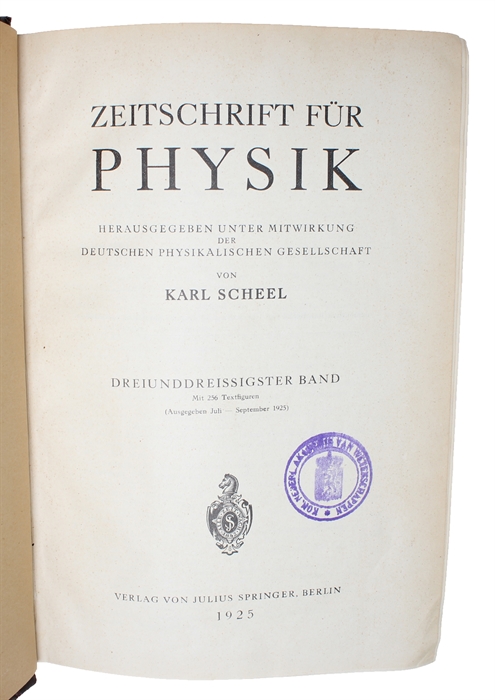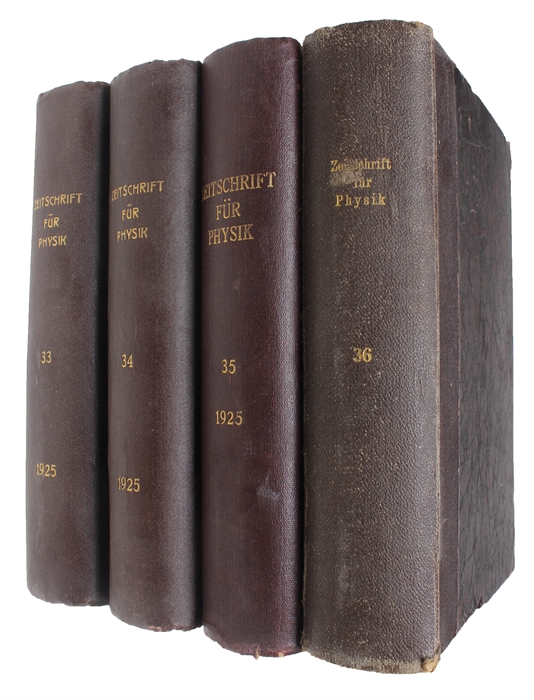THE BIRTH OF QUANTUM MECHANICS
HEISENBERG, WERNER & MAX BORN & PASQUAL JORDAN & WOLFGANG PAULI.
Über quantentheoretische Umdeutung kinematischer und mechanischer Beziehungen. (Heisenberg). With: Zur Quantenmechanik. (Born a. Jordan). With: Zur Quantenmechanik II. (Born, Heisenberg a. Jordan). With: Über das Wasserstoffspektrum vom Standpunkte der neuen Quantenmechanik. (Pauli). (4 papers).
Berlin, Julius Springer, 1925-26. Bound in 4 nearly uniform contemp. hcloth. Edges a little rubbed. Stamp on title-pages. In "Zeitschrift für Physik. Hrsg. von Karl Scheel", Vols 33,34,35 and 36. VII,950;VII,953;VIII,954;VII,951 pp. The offered papers: pp. 879-893 (vol.33), pp. 858-888 (vol.34), pp.557-615 (vol.35) and pp.336-363 (vol. 36). Internally fine and clean.
First printings of these four absolutely fundamental papers, which together MARK THE TURNING POINT IN THE FABRICATION OF A NEW PHYSICS, Quantum Mechanics, also called "Matrix Mechanics".
"In May 1925, Heisenberg took on a new and difficult problem, the calculation of the line intensities of the hydrogen spectrum. Just as he had done with Kramers and Bohr, Heisenberg began with a Fourier analysis of the electron orbits. When the hydrogen orbit proved too difficult, he turned to the anharmonic oscillator. With a new multiplication rule relating the amplitudes and frequencies of the Fourier components to observed quantities, Heisenberg succeeded in quantizing the equations of motion for this system in close analogy with the classical equations of motion.....in June Heisenberg returned to Göttingen, where he drafted his fundamental paper [the first paper offered], which he completed in July. In this paper Heisenberg proclaimed that the quantum mechanics of atoms should contain only relations between experimentally observable quantities. The resulting formalism served as the starting point for the new quantum mechanics, based, as Heisenberg's multiplication rule implied, on the manipulation of ordered sets of data forming a mathematical matrix....Born and his assistant, Pascual Jordan, quickly developed the mathematical content of Heisenberg's work into a consistent theory with the help of abstract matrix algebra [the second paper offered].Their work, in collaboration with Heisenberg, culminated in their "three-man paper" ["Dreimännerarbeit" - the third paper offered] that served as the foundation of matrix mechanics. Confident of the correctness of the new theory, Heisenberg, Pauli, Born, Dirac, and others began applying the difficult mathematical formalism to the solution of lingering problems." (DSB).
In the last paper offered, the Pauli-paper, he shows that the hydrogen spectrum can be derived from the new theory. His starting-point constitutes, due to Lez, a method for integrating the classical equations of motion of a particle in a Coulomb field. Pauli's paper was received on January 17, 1926, but the main result must have been obtained before November 3, 1925, for on that date, Heisenberg writes Pauli: "..Ich brauche Ihnen wohl nicht zu schreiben, wie sehr ich mich über die neue Theorie des Wasserstoffs freue..." Pauli's paper convinced most physicists that Quantum Mechanics is correct. (Van der Waerden).
Order-nr.: 39170


